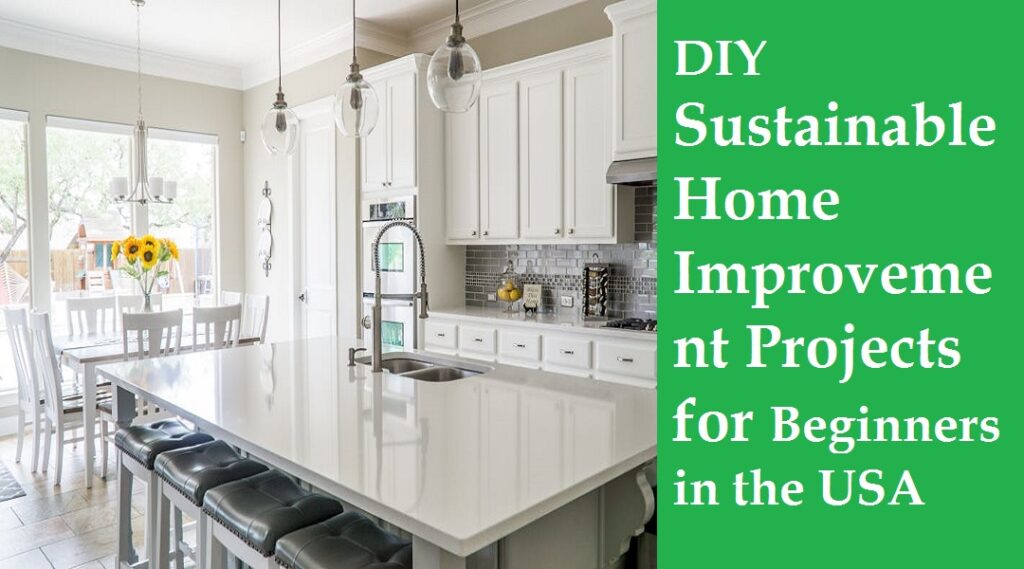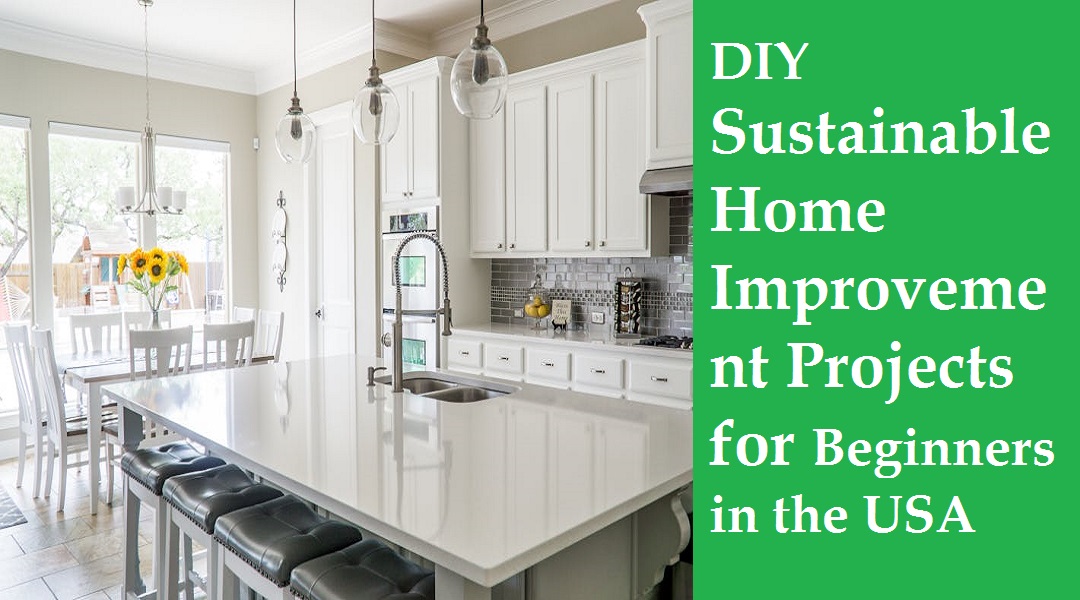
DIY Sustainable Home Improvement Projects for Beginners in the USA : In today’s environmentally conscious world, homeowners across the USA are increasingly turning to DIY sustainable home improvement projects. These projects offer a win-win situation: reducing your environmental impact while saving money and creating a more comfortable and healthy living space. Whether you’re a seasoned DIYer or a complete beginner, this comprehensive guide empowers you to embark on your eco-friendly home improvement journey. We’ll explore a range of beginner-friendly projects, from energy-efficient upgrades to upcycled decor, to help you create a sustainable haven.
DIY Sustainable Home Improvement Projects for Beginners in the USA
Lighting the Way with Energy Efficiency:
The easiest and most impactful way to start is with a lighting upgrade. Swap out those traditional incandescent bulbs for long-lasting, energy-saving LED lights. LEDs use up to 75% less energy and last 25 times longer, significantly reducing your carbon footprint and electricity bills. Consider smart lighting systems that learn your habits and adjust lighting based on occupancy and natural light, further minimizing energy waste.
Conserving Every Drop: Water Efficiency Hacks
Water conservation is vital, especially in drought-prone regions. Install low-flow faucets and showerheads to reduce water usage without sacrificing functionality. Look for models certified by the Environmental Protection Agency’s (EPA) WaterSense program, guaranteeing at least a 20% reduction in water use. Embrace rainwater harvesting by installing a rain barrel system. This collected water can be used for watering plants, washing your car, or even flushing toilets, significantly reducing your reliance on municipal water.
Sealing the Deal: Insulation and Weatherization
A well-insulated and weatherized home is key to sustainability and energy efficiency. Invest in insulating your walls, floors, and attic to minimize heat loss during winter and heat gain during summer. This reduces the strain on your heating and cooling systems, lowering energy consumption and utility bills. Seal any gaps and cracks around windows, doors, and vents using weatherstripping or caulk. These seemingly small fixes can make a significant difference in your home’s energy efficiency and comfort.
Flooring for a Sustainable Future
When it comes to flooring, choose sustainable materials like bamboo, cork, or reclaimed wood. These options are renewable, durable, and eco-friendly alternatives to traditional hardwood or carpeting. Bamboo boasts fast-growing properties, making it a highly sustainable resource. Cork flooring is naturally moisture-resistant and offers excellent sound insulation. Reclaimed wood adds a unique touch to your space while reducing reliance on virgin lumber. Opt for non-toxic and low-VOC adhesives and finishes to ensure a healthy indoor environment.
Landscaping with Nature in Mind
Transform your outdoor space into a haven for both you and the environment by practicing eco-conscious landscaping. Embrace native plants that require minimal water and maintenance, reducing the need for irrigation and harmful chemical fertilizers. These native plants also provide essential habitat for local pollinators like bees and butterflies. Consider incorporating permeable paving materials like gravel or permeable concrete. This allows rainwater to naturally infiltrate the soil, replenishing groundwater reserves and preventing runoff.
Harnessing the Power of the Sun: DIY Solar Panel Installation (Optional)
While installing solar panels might seem like an advanced project, there are beginner-friendly DIY kits available. Solar energy offers a significant advantage: reducing reliance on the traditional power grid and lowering your electricity bills. However, this project requires thorough research and potentially, professional assistance for safe and efficient installation. Explore various DIY solar panel options, understand local regulations and incentives, and ensure you have the necessary skills and tools before embarking on this project.
Upcycling and Repurposing: Giving Old Items New Life
Embrace the concept of upcycling and repurposing to breathe new life into old items and minimize waste. This not only saves you money but also reduces your environmental impact. Turn discarded pallets into stylish coffee tables or garden planters. Repurpose glass jars as storage containers for spices, dry goods, or bathroom essentials. Give outdated furniture a makeover with eco-friendly paints and finishes. The internet is overflowing with DIY tutorials and inspiration for upcycling projects, so get creative and explore your options!
Breathing Easy: Enhancing Indoor Air Quality
Improve your indoor air quality by incorporating natural air purifiers – houseplants! Plants like aloe vera, spider plants, and peace lilies not only add a touch of beauty to your space but also act as natural filters for common indoor pollutants. Invest in air-purifying filters for your HVAC system to capture dust, allergens, and other airborne particles. Additionally, use eco-friendly cleaning products free of harsh chemicals and synthetic fragrances to minimize indoor air pollution and create a healthier living environment.
Embrace the Sustainable Journey
Embarking on DIY sustainable home improvement projects is a rewarding journey that benefits both the planet and your well-being. By implementing energy-efficient upgrades, water conservation techniques, sustainable materials, and eco-conscious practices, you can create a more resilient and environmentally friendly home. Here are some additional tips to keep in mind:
Start Small and Scale Up:
Don’t feel overwhelmed by the idea of a complete home overhaul. Begin with a single project, like replacing light bulbs or installing a low-flow faucet. As you gain confidence and experience, tackle more ambitious projects.
Research Local Incentives and Rebates:
Many states and municipalities offer financial incentives and rebates to encourage sustainable home improvements. Check with your local government agencies or utility companies to see what programs are available. These incentives can significantly offset the cost of your projects.
DIY vs. Hire a Professional:
Be honest about your skill level. While many projects are beginner-friendly, some require specialized knowledge or tools. Don’t hesitate to hire a professional for tasks you’re unsure of tackling yourself.
Embrace Sustainable Habits:
Sustainable living goes beyond physical home improvements. Develop eco-conscious habits like unplugging electronics when not in use, washing clothes with cold water, and using reusable shopping bags.
Spread the Green Spirit:
Share your DIY journey and sustainable living practices with friends and family. Inspire others to embrace a more eco-friendly lifestyle, creating a positive ripple effect in your community.
Remember, sustainability is a continuous journey. By making small changes and incorporating these DIY projects into your home improvement plans, you can create a lasting positive impact on the environment and your wallet. Enjoy the process of transforming your living space into a sustainable haven, a place that reflects your values and fosters a healthy and comfortable lifestyle for you and your loved ones.
- Unleash the Harvest: Fast-Growing Vegetables for California’s Raised Garden Beds
 Fast-Growing Vegetables for California’s Raised Garden Beds : California’s golden sunshine, mild climate, and fertile soil are a gardener’s dream. Elevated planting in raised garden beds takes this advantage to the next level. These controlled environments offer improved drainage, easier pest management, and the perfect canvas for cultivating a fast and furious vegetable bounty. Fast-Growing… Read more: Unleash the Harvest: Fast-Growing Vegetables for California’s Raised Garden Beds
Fast-Growing Vegetables for California’s Raised Garden Beds : California’s golden sunshine, mild climate, and fertile soil are a gardener’s dream. Elevated planting in raised garden beds takes this advantage to the next level. These controlled environments offer improved drainage, easier pest management, and the perfect canvas for cultivating a fast and furious vegetable bounty. Fast-Growing… Read more: Unleash the Harvest: Fast-Growing Vegetables for California’s Raised Garden Beds - Pitbull Announces Party After Dark Tour With T-Pain: A Must-See Event for Music Lovers
 Pitbull Announces Party After Dark Tour With T-Pain : Pitbull, the renowned artist known for his electrifying performances and chart-topping hits, has recently announced the much-anticipated “Party After Dark Tour” featuring none other than the iconic T-Pain as a special guest. This tour promises to be a spectacular celebration of music, bringing together two powerhouse… Read more: Pitbull Announces Party After Dark Tour With T-Pain: A Must-See Event for Music Lovers
Pitbull Announces Party After Dark Tour With T-Pain : Pitbull, the renowned artist known for his electrifying performances and chart-topping hits, has recently announced the much-anticipated “Party After Dark Tour” featuring none other than the iconic T-Pain as a special guest. This tour promises to be a spectacular celebration of music, bringing together two powerhouse… Read more: Pitbull Announces Party After Dark Tour With T-Pain: A Must-See Event for Music Lovers - Unwind with Your Furry Friend: Pet-Friendly Cabins with Private Hot Tubs near Yellowstone National Park
 Pet-Friendly Cabins with Private Hot Tubs near Yellowstone National Park : Yellowstone National Park, a crown jewel of the American wilderness, beckons adventurers with its geysers, hot springs, and breathtaking landscapes. But what if you could experience this wonder alongside your furry best friend? Imagine returning from a day of exploring the park’s marvels, sharing… Read more: Unwind with Your Furry Friend: Pet-Friendly Cabins with Private Hot Tubs near Yellowstone National Park
Pet-Friendly Cabins with Private Hot Tubs near Yellowstone National Park : Yellowstone National Park, a crown jewel of the American wilderness, beckons adventurers with its geysers, hot springs, and breathtaking landscapes. But what if you could experience this wonder alongside your furry best friend? Imagine returning from a day of exploring the park’s marvels, sharing… Read more: Unwind with Your Furry Friend: Pet-Friendly Cabins with Private Hot Tubs near Yellowstone National Park - Cultivate Your Dreams: Building a Raised Garden Bed in Tight Spaces
 Building a Raised Garden Bed in Tight Spaces : For city dwellers and space-conscious gardeners, the dream of fresh, homegrown produce might seem like a distant utopia. But fret no more! Raised garden beds offer a game-changing solution, transforming even the most limited balconies, patios, or sunny nooks into flourishing mini-farms. Building a Raised Garden… Read more: Cultivate Your Dreams: Building a Raised Garden Bed in Tight Spaces
Building a Raised Garden Bed in Tight Spaces : For city dwellers and space-conscious gardeners, the dream of fresh, homegrown produce might seem like a distant utopia. But fret no more! Raised garden beds offer a game-changing solution, transforming even the most limited balconies, patios, or sunny nooks into flourishing mini-farms. Building a Raised Garden… Read more: Cultivate Your Dreams: Building a Raised Garden Bed in Tight Spaces - Best Organic Mattresses for Back Pain Sufferers Under $1,500
 Best Organic Mattresses for Back Pain Sufferers Under $1,500 : Waking up with a crick in your neck or lower back pain can put a damper on anyone’s day. But for chronic back pain sufferers, a good night’s sleep can feel like a distant dream. The right mattress can make a world of difference, providing… Read more: Best Organic Mattresses for Back Pain Sufferers Under $1,500
Best Organic Mattresses for Back Pain Sufferers Under $1,500 : Waking up with a crick in your neck or lower back pain can put a damper on anyone’s day. But for chronic back pain sufferers, a good night’s sleep can feel like a distant dream. The right mattress can make a world of difference, providing… Read more: Best Organic Mattresses for Back Pain Sufferers Under $1,500



